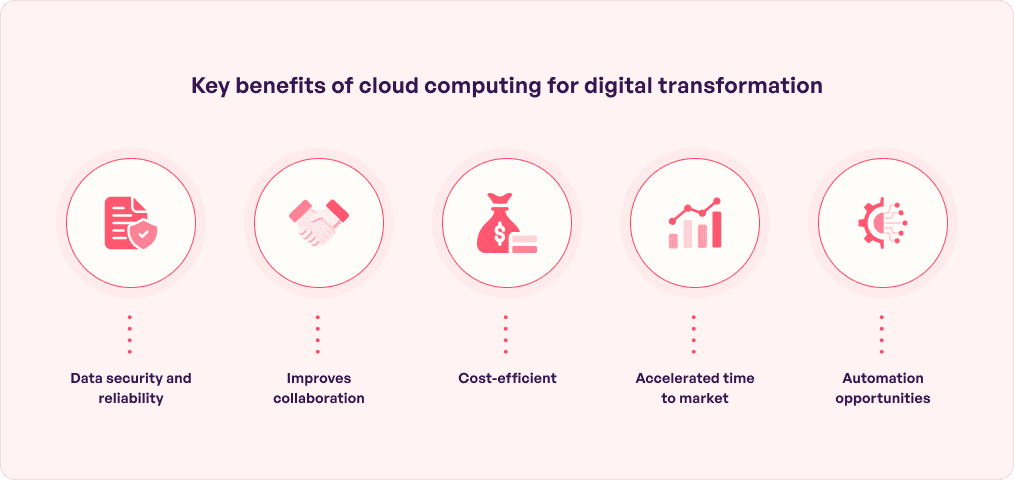In the current digital landscape, businesses face pressure to be competitive, change-ready, innovative, and fast scaling. All these requirements when brought under an umbrella term, become digital transformation.
While not a new concept, digital transformation has remained a north star in the business landscape because of a lack of total adoption. Of 91% of companies with a digital transformation initiative, only 35% have been successful. So what does it mean for a company to be digitally transformed?
For some entrepreneurs, it is the digitalization of traditional processes while for others it is using technology in business processes, customer experiences, and culture. While the end goal of the efforts can vary from company to company, one thing is clear: legacy technology investments that once differentiated organizations no longer suffice. This has led to the onset of cloud computing in digital transformation.
In this article, we will explore the nuances of the cloud in digital transformation – its role, the best implementation strategies, and challenges. The idea here is to prepare you for taking your business to the next level with the capabilities of cloud technology.
Table of contents
The role of cloud computing in digital transformation
Emerging as the foundation of digital transformation efforts, the cloud is pushing companies toward their always-online versions with the ability to harness innovation and unlock hidden growth opportunities.

Unmatched flexibility and agility
One of the biggest signs of cloud accelerating digital transformation can be seen in the agility and flexibility the technology offers. The days of on-premise infrastructures and legacy systems are long gone. With the ease of scaling resources (up or down) effortlessly, businesses are entering a new era of multi-scenario adaptation – one where they are launching new products, entering new markets, and unlocking immense growth opportunities.
High cost efficiency
The combination of cloud computing and digital transformation brings forth massive cost efficiency for a company. With the cloud, businesses only have to pay for the resources they use while eliminating all the capital expenses, maintenance costs, and the efforts of managing dedicated teams.
Typically, the cost of digital transformation is explored through three dimensions –
- Calculation of the potential value from IT cost efficiencies around app development and infrastructure spending.
- Cost saving from business operations that focus on IoT, analytics, and automation.
- Costs of exploring new business opportunities with the help of new-gen technologies.
Cloud for digital transformation has a role to play in all three dimensions, making them affordable and accessible for businesses across multiple sizes.
Real-time collaboration
With the corporate world moving to the hybrid mode of operations, cloud-powered collaboration and messaging platforms come to the forefront. Through cloud computing and digital transformation, the teams can access documents and interact with their and other teams from anywhere across the globe. This transition from physical to digital operations, helps businesses double their productivity and unleash incredible innovation with half the money and efforts.
Better security and compliance-readiness
Security breaches have sadly become part and parcel of digitalization. Cloud computing, however, addresses this head-on. The top cloud enabled digital transformation providers like AWS, Microsoft Azure, Google Cloud Platform, etc. invest extensively in encryption protocols, security measures, and unplanned audits to ensure that their infrastructure remains hack-proof.
Supporting innovation
Cloud transformation helps businesses tap into the capabilities of new-gen technologies and toolsets. To remain competitive in the cloud space, providers tend to constantly update their offerings to add the latest advancements in AI, ML, IoT, and now generative AI. Because of this, companies get a readymade repository of innovative tools, ready for experimentation, development, and deployment.
The benefits of combining digital transformation and cloud computing can truly be realized after its correct implementation in the organization. Let’s look into the stages of integrating the cloud into your operations.
How to implement cloud computing in digital transformation?
When working on the implementation of cloud enabled digital transformation, here are the stages that your organization might come across.
Plan
In addition to outlining the key success metrics, your cloud transformation planning should answer the following questions – what does a successful cloud strategy mean for your business? Do you completely want to move an application to the cloud? What would be the learning curve for your team? What percentage of downtime are you expecting?
Identify roadblocks
Know potential issues you might face when you move your processes to the cloud. For some businesses it is security, for others it can be complex migration efforts and team resistance. Find the challenge specific to your organization and see if it is something that you can eliminate with the help of resources you currently have.
Modernization decisions
Spend time evaluating your infrastructure needs, if there are resources that you are currently hosting but are not necessary, don’t bring them to the cloud. To make this decision easy, you should look into the areas that would benefit from modern technologies or approaches and the cost, time it would take to make them cloud-only.
Cloud deployment
Once you have clarity on the processes that will be modernized, the next step that comes is deployment. It is one of the key stages of cloud transformation where the processes are categorized into bite sizes and migrated to the cloud on a module-by-module level. It is during this phase that access is shared between the right owners and team members and user acceptance testing is carried out on a company level.
Seems pretty straightforward, doesn’t it? On paper it is, but in reality, several things can go wrong with migration. This is where it becomes critical to look into the best strategies and practices.
Best practices and strategies for digital cloud transformation
By now you must have understood how cloud is the key to businesses innovating quickly, scaling efficiently, innovating easily, and seizing new market opportunities faster. However, to maximize the outcome of cloud computing and digital transformation, it is important to follow the best strategies and practices.
Define your roadmap and cloud strategy – As you get on your cloud digital transformation journey, plan a well-established roadmap and strategy. This means setting up clear objectives, aligning the efforts with business strategies, and understanding the user’s needs. Roadmap, on the other hand, should chart the timelines, steps, and milestones of implementation.
Select the right cloud model – Choosing the best cloud deployment model is crucial to establish the suitability of cloud migration. The decision between the three prominent cloud models can have implications like refactoring, re-architecting, replacement, or retirement.
While IaaS gives fundamental computing resources, PaaS provides development environments, on the other side, SaaS delivers ready-to-use applications and FaaS powers the developers to run individual functions with a cost-effective approach.
Prioritize cloud-native applications – Building and deploying cloud-native software designed especially for the cloud promises agility, scalability, and resiliency at the back of serverless architecture, DevOps, and microservices practices.
These applications are known to integrate effortlessly with on-premise and cloud-based applications which ultimately power innovation and flexibility in the system.
Monitor performance and cloud resources – Ongoing monitoring and management of cloud resources are critical for ensuring the reliability, availability, and security of data and processes. Additionally, we recommend orchestration and automation of resource management and provisioning to get 360-degree control, visibility, and optimization of cloud operations.
Implement cloud governance – Establish a security framework and governance that would define standards, policies, and best practices for cloud usage. This framework that you build must comprise factors like access and identity management, data protection, incident management, and a business continuity plan.
While the above-mentioned stages can help with the right implementation of cloud computing and digital transformation, companies should remain wary of the challenges that they might encounter in the journey.
As we near the end of the article, let’s look into some challenges that businesses can face with cloud adoption and their solutions.
Overcoming challenges in digital transformation
Let us explore some of the most commonly occurring roadblocks for businesses looking to reap the benefits of cloud computing and their best probable solutions.
Security
Keeping the data secure in the cloud system can sometimes pose a challenge, especially since the cloud providers tend to share their resources and infrastructures with multiple companies. The solution to this lies in integrating security mechanisms and monitoring cloud environments for vulnerabilities. We recommend using access controls, encryption, and security audits to protect the data.
Cost management
Cloud computing can get expensive when not managed accurately. Businesses tend to face unplanned expenses because of storage, overprovisioned resources, and data transfer in multi-cloud environments. Solutions that we propose for this are using cloud cost management tools like Cloud Health and CloudWatch, implementing auto-scaling for adjusting resources based on demand, reviewing cloud usage to identify areas where one can cut costs, etc.
Data migration
Transferring data to the cloud can lead to probable data loss and downtime during the migration journey. Tackling this expensive activity would require you to choose a migration strategy between re-platforming, lift-and-shift, and refactoring. Additionally, you should follow practices like backing up your data, performing test migrations, and having a rollback strategy in case of issues.
Multi-cloud strategy
Handling different cloud environments with their own set of APIs, tools, and billing structures, can complicate the process of gathering an overview of the cloud expense and usage. Solving this would require you to invest in a cloud management platform that gives you a clear view of all your cloud-powered activities.
How can Simublade help with your cloud transformation journey?
In our role as a trusted digital transformation services provider, who has a dedicated expertise in cloud solutions, we have helped many businesses across different cloud journeys.
We have helped a few companies establish their cloud infrastructure by moving their data to a reliable cloud platform and for some we have kept a more consultative approach where we have aided them in choosing between the best providers after a thorough cost-benefit analysis.
Looking for similar assistance? Get on a call with our cloud consultancy services experts today.
FAQs
Q. What is cloud enabled digital transformation?
A. Cloud-powered digital transformation is the process of adopting and making use of cloud computing technologies to transform the ways a business operates and delivers value to its customers, employees, and partners.
Q. What are the advantages of cloud computing in digital transformation?
A. The benefits of cloud computing in digital transformation can be seen in unmatched flexibility and agility, high-cost efficiency, supporting innovation, powering real-time collaborations, and in ensuring compliance readiness.
Q. Which cloud is most suited for your business objectives?
A. It depends entirely on your needs. Public clouds are considered to be cost-effective and scalable but can raise security concerns. On the other hand, Private clouds provide enhanced security but can exceed the organization’s budget. Hybrid clouds provide a middle ground, allowing businesses to optimize workload and data distribution
Q. How can Simublade help in our cloud computing initiatives?
A. Our cloud experts at Simublade can play an active role in your entire cloud transformation journey. Right from suggesting the best cloud service platform to planning out your migration strategy and deploying your processes on the cloud – our team can do it all.





